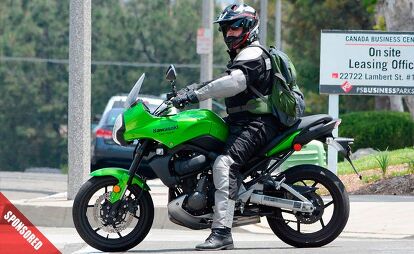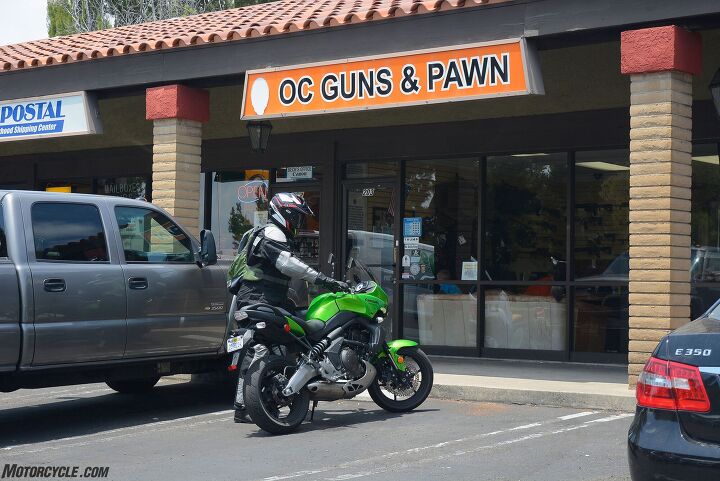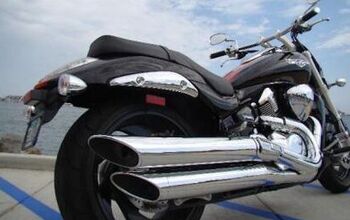Riding With a Gun
Regardless of an individual’s position on firearms, the simple fact of the matter is that motorcycle ownership and gun ownership often go hand in hand.
There are millions of peaceable, law-abiding, motorcyclists who own firearms for a wide variety of reasons, typically personal protection or for the simple enjoyment of target shooting or hunting. You’ve probably heard it a million times and argued for or against it in several different ways, but the right to keep and bear arms is guaranteed under the Second Amendment to the Bill of Rights of the U.S. Constitution.
But that right to bear is not absolute, and exercising it properly has a lot in common with riding your favorite two-wheeler on public roads. Simply put, enjoying either freedom requires tremendous discipline in order to avoid running afoul of local laws. Ignorance of a specific law is no excuse, and that includes laws governing a person’s right to carry, or even transport, a firearm on a motorcycle. Riding with a gun is easy to do and nothing to be afraid of, but it is the responsibility of any motorcyclist to ensure that he or she transports any firearm in a manner that is compliant with the laws governing their route.
Knowing what is allowable, and what is required, under federal, state and local laws can mean the difference between being able to exercise a right and possibly losing it for good. Get it right, and there is really nothing to fear. Get it wrong and you could face fines, arrest, court appearances, or even incarceration…. A loss of mucho dinero – or worse – no matter how you slice it.
Ignorance of a specific law is no excuse, and that includes laws governing a person’s right to carry, or even transport, a firearm on a motorcycle.
Please note our wording from above: “a person’s right to carry, or even transport…”, we worded it that way because those two terms refer to distinctly different acts in the legal context of firearms. “Carrying” a firearm is the act of having a ready to use firearm on your person or easily accessible on/in your vehicle. However, “transporting” is simply the act of moving personal firearm(s) from one place to another. In the eyes of the law “carrying” is a much more serious and complex issue.
Frankly, we wanted to know the ins and outs ourselves, because several Motorcycle.com staffers are avid shooters who naturally also happen to spend a lot of time on motorcycles. It is logical to assume that we aren’t alone, so transporting a firearm on a motorcycle without a concealed carry permit is a subject of great interest to us. Thus, we did some digging and found workable solutions for most situations.
That said, it is important to note that we are not dispensing legal advice here, and neither we nor our parent company should be considered liable for any legal hassles that arise from following the suggestions contained herein. Anyone considering the transportation of a firearm while riding a motorcycle should contact their local law enforcement agencies or check with an attorney to clarify the legal requirements in their locales. In the end, it is your responsibility to know and obey the specific laws governing your ride route(s).
For this investigation, Motorcycle.com began with the support of Springfield Armory and the loan of a brand new Springfield XD Essentials 9mm pistol. As with most of his personal firearms, our Editorial Director, Sean Alexander, chose the XD-9 for the primary purpose of target shooting, although its 4-inch barrel does offer a nice compromise between compactness and providing sufficient velocity for the 9mm cartridge to do its most effective work in a self-defense situation. Frankly, a tiny “carry” pistol wasn’t something in which we were interested, since none of us currently possess a CCW permit in our home state of California.
At the range the relatively inexpensive XD proved surprisingly nice to shoot with a natural pointing ability and smooth cycling from shot to shot. It was also extremely accurate for a sub-$500 production pistol straight out of the box and it reliably fed and fired several different types of ball target and hollow-point defense ammunition ranging from 115 – 147 grains. It’s an impressive piece, especially considering its $459.99 price point at our local gun store.
Assuming that a firearm owner is in good legal standing to transport a firearm for lawful purposes but does not possess a concealed carry permit for their state or county, transporting a firearm on a motorcycle can be done, but we’ve found that it must be done a certain way in most states if you want to avoid being hassled by the man.
In some states, the process is surprisingly easy. Currently, a number of states are classified as “unrestricted,” meaning that any person in good legal standing can open carry or even concealed carry the firearm during transport, with no permit required whatsoever. These states include Alaska, Arizona, Idaho (effective July 1, 2016), Kansas, Maine, Vermont, West Virginia (effective June 5, 2016) and Wyoming. For the rest of the United States, concealed carry and open carry are subject to restrictions either by the state as a whole or even from city to city or county to county within a state. The waters are especially murky if you live in New York or Maryland, where the Big Apple itself prohibits possession of any firearm while traveling within the city limits unless you have a state-issued permit. Likewise, Washington D.C. has restrictive possession and carry laws.
Our recommendation? Know the requirements of these areas before you make the decision to ride a motorcycle with a gun in your possession, or just avoid these parts of the country altogether. If you do get stopped in one of these restrictive areas, it is best to make it clear from the get-go that you are just passing through, and that may not fly at all if you happen to be pulled over on a surface street in downtown Manhattan or Washington D.C..
The good news is that federal law recognizes the right of any law-abiding citizen to transport a firearm from point to point for lawful purposes as long as certain conditions are met. Title 18 Section 926(a) The Peaceable Journey Act, under Part 1, Chapter 44, of the federal code provides that:
“Notwithstanding any other provision of any law or any rule or regulation of a State or any political subdivision thereof, any person who is not otherwise prohibited by this chapter from transporting, shipping, or receiving a firearm shall be entitled to transport a firearm for any lawful purpose from any place where he may lawfully possess and carry such firearm to any other place where he may lawfully possess and carry such firearm if, during such transportation, the firearm is unloaded, and neither the firearm nor any ammunition being transported is readily accessible or is directly accessible from the passenger compartment of such transporting vehicle: Provided, that in the case of a vehicle without a compartment separate from the driver’s compartment the firearm or ammunition shall be contained in a locked container other than the glove compartment or console.”
That’s comforting, except that what constitutes “lawful transport” may vary from state to state, and being stopped by law enforcement and found to be in possession of a firearm in places with more stringent gun regulations, such as New York, Washington D.C., Illinois or California, may create hassles you never dreamed of. For instance, California, Colorado, Connecticut, Hawaii (on handguns only), Maryland, Massachusetts, New Jersey and New York also have laws that restrict magazine capacity on semi-automatic firearms — usually to 10 rounds — and it is a major violation for anyone to import magazines able to accept more rounds than are allowed in those states.
So, as you can see, lawfully transporting a firearm requires some careful research, but does that mean you shouldn’t do it? That’s really your decision to make, but we would. We’re also confident that our method of transportation will survive legal scrutiny.
First and foremost, most states require that any firearm transported –for lawful purposes from one place where it is legal to possess it to another place where it is legal to possess it– be unloaded. That’s common sense but it’s also just the tip of the iceberg.
It is important to note that slipping an unloaded firearm into your jacket pocket and heading out on the highway is an invitation to trouble, since that constitutes a “carry” situation and most states require a permit if you want to “carry” concealed (out of sight). While it is true that carry permit reciprocity between states has increased over the past few years, if you plan to carry a concealed firearm in a restricted state you need to be absolutely certain that where you are going recognizes the permit issued by your home state. Otherwise, things could quickly turn criminally ugly.
But if you don’t have a specific permit, the smartest way to avoid a “carry” hassle is simply to follow the rules of the Peaceable Journey Act by keeping your firearm stored in a locked container out of your immediate reach during transport. For motorcyclists, that means transporting the firearm in a locked container within a saddlebag or backpack whenever possible, and keeping any ammunition in a separate locked container, like the other saddlebag, or a separate locked box.
What if you don’t have a lockable case or a saddlebag in which to store your gun during “transport”? Even more precautions should be taken, such as rendering the firearm inoperable via the addition of a trigger lock, long padlock or a lockable cable that extends through the breech, the barrel or the magazine well of your gun. If you should be pulled over and are asked to present the firearm to a law enforcement officer, the fact that you are transporting a firearm locked in this manner will act as a strong signal to the officer that your intention is not to commit a crime or violate any “carry” laws.
And how would an officer know that you have a firearm in your backpack or saddlebag? Simple: If stopped for any reason, you’re going to calmly and clearly declare it. Immediately.
And how would an officer know that you have a firearm in your backpack or saddlebag? Simple: If stopped for any reason, you’re going to calmly and clearly declare it. Immediately. That in itself may sound like an invitation to search and seizure, and you might feel that such an admission right off the bat is somehow violating your right to privacy. If you want to set that kind of adversarial tone, more power to ya’, but you may already be in violation of the law if you keep your mouth shut because several states — even some with unrestricted carry and transport laws — have enacted “Duty to Inform” statutes that make it incumbent on any person in possession of a firearm to inform the officer of that fact when they interact with law enforcement.
Alaska (Alaska Stat. Ann. §11.61.220), Arkansas (Ark Admin. Code 130.00.8-3-2(b), Delaware (Griffen v. State, 47 A.3d 487), Illinois (430 ILCS 66/10), Louisiana, Michigan (MCL 28.425f(3)), Nebraska (Neb. Rev. Stat. §69-2440), North Carolina (N.C. Gen. Stat. Ann. §14-415.11), Ohio (Ohio Rev. Code Ann. §2923.16), Oklahoma (Okla. Stat. Ann. tit. 21, §1290.8), South Carolina (§23-31-215) and Texas (must provide permit when asked for ID, §411.205) all have such statutes on the books, but even if you’re not sure whether the state you’re in has such a law, our suggestion is still to let the officer know that you are responsibly and lawfully transporting your firearm, and if he or she asks to see it, you should calmly and slowly tell them where it is and ask for their permission to get it out before you go reaching for it.
More than likely, doing so will put the officer’s mind at ease that your intent is to comply with the law and that you are willing to cooperate fully. That simple act will often go a long way toward helping you if you are actually in violation of some obscure law or another minor offense such as speeding. Granted, it’s no guarantee, but know it works because, on more than one occasion, some of our staffers (Sean) have been let off with a warning for such violations simply because they were forthright and cooperative about the fact that they were legally transporting a firearm. Don’t count on it, but it sure seems to help.
If you are stopped and you calmly present an unloaded and inoperable firearm in a locked container and show any ammunition is locked in a separate container, the officer may still insist on hassling you about it. If so, remain calm and by all means do not argue on the side of the road. However, it may also be possible that he or she simply isn’t certain about what is permissible when it comes to legal transport for lawful purposes. That’s why we suggest keeping a printed copy of the Peaceable Journey Act, complete with the title and section numbers, with you at all times. After all, it is federal law, which ultimately supersedes state or local laws whether the officer wants to admit it or not. Having a copy on hand is no “get out of jail free” card, and your intention is not to argue with the police but simply to make it clear that you have done your homework on the issue.
If you still don’t feel confident that you will avoid being “busted” even if you follow the aforementioned guidelines for legal “transport”, consider that virtually the same requirements are set forth in Canadian law. Our research of the Royal Canadian Mounted Police website revealed that what Canada considers “non-restricted” firearms (basically any rifle or shotgun that does not feature automatic-fire capability) must be unloaded during transportation, while restricted and prohibited firearms (namely revolvers and handguns) must be unloaded, affixed with a secure locking device such as a trigger lock, padlock or a lockable cable through the barrel or the magazine well and locked in a sturdy, non-transparent container. Canadian law even specifies that automatic firearms have their bolts or bolt carriers removed if they can be removed. Canada also requires that a citizen obtain an Authorization to Transport, and the RCMP website even provides a contact phone number.
At the end of the day, transporting any legal firearm on your motorcycle for lawful purposes, such as when heading to the range, your favorite hunting spot or your local gunsmith, need not be a source of anxiety as long as you follow these guidelines:
DO
- Transport your firearm unloaded.
- Do store your firearm in a locked container.
- Do store ammunition in a separate, locked container.
- Do transport firearms and ammunition as far away from easy reach as is practically possible for that vehicle (for a motorcycle that means a backpack or saddlebags).
- Do enjoy shooting. Do enjoy riding… do NOT enjoy shooting while riding.
DON’T
- Don’t carry a loaded firearm unless you have a permit to do so.
- Don’t carry a firearm inside your jacket or clothing unless you have a concealed carry permit or that particular state specifically allows it without a permit.
- Don’t transport a firearm within easy reach.
- Do not handle, show, or demonstrate the firearm outside of your garage, a firing range, or a gun shop.
- Don’t speed excessively or ride recklessly with a firearm… not getting stopped in the first place is a great way to avoid law enforcement interactions while transporting your gun.
While following this advice may not exempt you from being hassled by the man in the event you get pulled-over, properly locking and storing your firearm during lawful transportation will significantly reduce your chances of being locked up.
Concealed Carry
A MO reader offers his first-hand experiences on legally “carrying” a concealed firearm while riding
While researching this story, we figured there had to be a few Motorcycle.com readers who actually carry a concealed firearm while riding and who have obtained a permit to do so. Finding one was easy, as our recent point-counterpoint on firearms generated a fair amount of reader feedback. One of those readers was John Butrus of Dallas, Texas, a lawyer who also happens to moonlight as a professional poker player.
Butrus, 55, often rides his Kawasaki Concours 14 from state to state to play in poker tournaments, and he carries his firearm whenever and wherever he is legally allowed to do so.
“I took up riding about five years ago, and mostly what I like to do is go on long trips,” Butrus said. “I cross state lines a lot, I go to national parks and state parks. And, obviously, when you ride you wind up in restaurants and bars. I go to sporting events.”
Being a lawyer, Butrus did a lot of research into the legalities of carrying a firearm on his person when travelling on his motorcycle, although he stresses that he is not here to dispense legal advice; he is merely relating his own experiences, and his mindset, with regard to carrying a firearm.
“I just wanted to make sure that I didn’t wind up somewhere where it is a big problem,” Butrus said. “Like, for example, if I took a gun and rode to New York or New Jersey, that could be a major problem if I got stopped.”
Part of the issue that permitted carry holders face is simply keeping up to date on all of the changes in the gun laws from state to state. Lately, the trend has been that states are becoming more permissive when it comes to carrying a firearm. In Butrus’ home state of Texas, for example, the law was recently changed to allow persons with a valid concealed carry permit (CCW) to also open carry — in other words, carry a loaded firearm that is visible for all to see. Prior to January 1, the law required that CCW permit holders were required to keep their gun concealed at all times. That created some problems, according to Butrus.
“For example, if you are riding somewhere and you kept your gun concealed in a tank bag, and you stopped for gas, you either had to leave the gun in your tank bag or figure out a way to carry it on your person. But if someone saw you holding the gun, then it is no longer concealed. Texas was also considering letting everyone open carry, but that’s just kind of ridiculous. So, they limited it only to people who qualify for the (CCW) license.”
Like many of the gun laws themselves, CCW permit qualification requirements often differ from state to state. The vetting process usually involves a comprehensive application procedure that includes a thorough background check, personal interviews by law enforcement, fingerprinting and the applicant’s ability to demonstrate that he or she can safely operate a firearm as well as use proper judgment in a situation that could mean the difference between life and death.
And some states are classified as “shall issue” while others are “may issue” when it comes to CCW permits. Currently, 41 states are “shall issue,” meaning that anyone who clears the vetting process in their state must be granted a CCW permit. Nine states — California, Connecticut, Delaware, Hawaii, Maryland, Massachusetts, New Jersey, New York, and Rhode Island — are “may issue,” which leaves discretion for issuing a CCW permit to state or local authorities, who will usually stipulate that an applicant be able to show “good cause” for carrying a concealed weapon.
There appears to be no one-size-fits-all reason when it comes to being able to demonstrate good cause, and although this requirement has recently been challenged in the State of California, the argument that it is within one’s Constitutional rights to keep and bear arms simply does not qualify as good cause. And even if a person is issued a CCW permit in their home state, that does not mean that the permit is necessarily valid across state lines.
“There are a ton of websites that tell people which states have reciprocity, and every state has different requirements. And the thing is that if you would not qualify to carry in that state, you are not allowed to carry in that state. For example, if I ride into New Mexico, which I do all the time, New Mexico might have a provision that says that you cannot get a concealed carry permit if you are behind on child support — and I’m just being hypothetical here. I don’t know if that is the case. But if that were the case, and Texas does have reciprocity with New Mexico on concealed carry permits, and you get stopped in New Mexico and they find out that you are behind on child support, you are not eligible to carry in New Mexico. It is fairly complicated to figure out if you can carry concealed in another state with reciprocity. You really have to study their statutes to know whether you would qualify to carry in their state.”
And there is even more to carefully consider when crossing state lines with a concealed firearm. After all, it stands to reason that most permit holders do so in the interest of self-defense, but it is also crucial that they have an understanding of what constitutes self-defense.
“The law for use of deadly force varies,” Butrus said. “Hopefully you would never get into a situation where you might actually have to shoot someone, but you sure as hell want to make sure you are justified in doing it. I’ll give you a quick example in Texas: I don’t know why, but a couple years ago they changed the law so that if someone is creating mischief on your property you can shoot them. I think it was because prowlers were getting shot and then they wanted to hold the homeowner liable. But if you don’t know when you can use your gun, you could end up in major trouble.”
Although admittedly never having been in that situation, Butrus has found that the law enforcement officers he has encountered have been very understanding when made aware that he has a concealed carry permit and is carrying his firearm
“One time I was on my way back from New Mexico, and I was just east of Lubbock [Texas],” Butrus said. “It was early in the morning and it was a wide open road, and I was just kind of enjoying the ride when I came over a hill. There was a sheriff on the left shoulder, and he pulled me over and said I was going 104 mph. When I got my license out, he saw that I was carrying a concealed carry permit. Now, a lot of times I will just show them my permit anyway while I am giving them my driver’s license because that tells them you’re not a dangerous person and that you don’t have a criminal history. That will sometimes calm them down a little bit, and he ended up just letting me off with a warning. He never even asked me if I was carrying or not.
“They know what the requirements are to get a permit — background checks, fingerprints to the FBI, no history of addiction, no felonies, no domestic violence,” Butrus added. “It’s really hard. But, they do keep statistics on crimes committed by permit holders, and it is like nothing other than traffic offenses. Literally nothing. So, if you’re a cop who is pulling a 55-year-old guy with a permit, he is probably not the guy who is going to be giving you a hard time.”
Butrus said that he is always forthright about whether or not he is carrying his firearm when dealing with law enforcement.
“I’ve been stopped a few times in my car, and I always show them my permit, which looks just like a driver’s license,” Butrus said. “If I have a gun, I tell them, and if I don’t have a gun, I tell them. If I do have one, I tell them where it is and then ask them how they want to proceed. If it is in my pocket, I want them to know that it’s there, or if it is in my glove compartment I want them to know that it is there so that if I open up either one they will not think that I am reaching for a gun. You have to be careful how you handle the situation.”
More by Scott Rousseau
























































Comments
Join the conversation
A little advice for the author. While your concern seems genuine and for the most part, your information is accurate, it does not address important issues. For starters, you used a term that to me any many others is an act of treason and even war. When ever a politician, judge, or anyone with judicial authority utters the words that a specific "guaranteed right" is not absolute, to me that's calling me out to fight. When our founders died to bring us those rights and hundreds of thousands died and continue to die to preserve those rights, their death is absolute! Nothing angers me more than to hear from anyone that a BoR is not absolute. Other issues are borderline but reasonable to call advice on your part. With that, I guess it can be taken as a good guide.
http://www.uspca.us
Only one picture of the Indian? Sheesh... :(